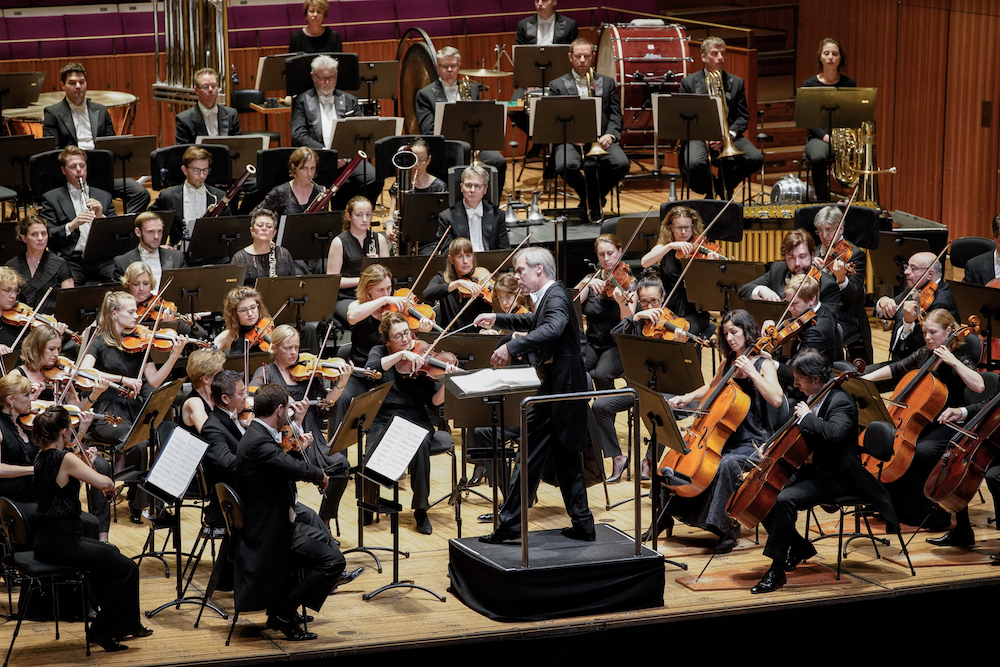The Sydney Symphony Orchestra’s Bartók’s Concerto for Orchestra was a well thought-out program, spanning 100 years between 1918 when Janáček’s Rhapsody for orchestra Taras Bulba was completed and 2018 when Steve Reich wrote his Music for Ensemble and Orchestra.
 David Robertson and the Sydney Symphony Orchestra. Photo © Christie Brewster
David Robertson and the Sydney Symphony Orchestra. Photo © Christie Brewster
The performance of Janáček’s three-movement work blended the sonorities of the pipe organ and the orchestra perfectly, which is a compliment to the orchestral tuning. This varied work is based on three grisly episodes from the life of the military hero of Gogol’s story. It contains many memorable moments, particularly a graphic depiction of an execution using the high-pitched shriek of the clarinet (chillingly done). It begins, however, with a beautiful, lyrical theme from the oboe. With Diana Doherty starting the piece off, what could go wrong? Janáček’s mosaic structure, full of motivic repetitions, suits the athletic, clean conducting style of David Robertson, who deftly created an integrated whole from the composer’s contrasting ‘blocks’ of music.
It was telling to follow Janáček’s trademark repetitions with a piece by one of the American minimalists. Commissioned by several orchestras including the Sydney Symphony Orchestra, this work marks Steve Reich’s return to the orchestra after spending some time writing for his own ensemble. In five continuous movements, the piece is a concerto grosso, with a group of soloists drawn from the violins and woodwinds, joined by two unrelenting pianos (played by Lisa Moore and Sally Whitwell) and tuned percussion (the concertante), supported by the rest of the orchestral strings and brass (the ripieno). Compared to Reich’s early minimalist work, this music is much more varied harmonically. Some of the harmonies were almost ‘Broadway’! It also showed a greater lyrical impulse, which Robertson emphasised in his conducting of Reich’s long melodic phrases. I could not tell where every movement started and ended (except of course where the first started and the last ended), but I felt the central section was too drawn out. Also, the acoustic of the Concert Hall muddied some textures: this was music I would have preferred to hear in a clearer acoustic such as that of the City Recital Hall. Still, it’s a beautiful, haunting piece, very smartly played.
Béla Bartók’s Concerto for Orchestra (1943), which concluded the concert, needs no introduction. It too got an excellent performance, although the orchestra seemed to have relaxed after the fierce concentration required for Reich. There were minor flubs from an oboe and trumpet, for example. Most performances of Bartók’s masterwork treat it as a spectacular showpiece (which it is), but I like the ones that also bring out the composer’s homesickness. Bartók wrote it for Koussevitzky’s Boston Symphony while he and his wife were living in America, suffering from illness and poverty and feeling alienated. You can hear this in the central movement’s journey from passionate outbursts to an uneasy calm. Robertson conveyed that emotion, with heartfelt playing from the viola section especially. In the Scherzo second movement I felt he was a tad fast: the music lost its jovial character as a result. Robertson always likes to whip up excitement at the end of a big work (if it’s justified), and he did so, but the excitement was not maintained throughout the entirety of the final movement. Despite its changes of tempo, the greatest performances still manage to keep up the tension. Nevertheless, the Concerto made an enjoyable end to the program, notably showing off the work of the SSO woodwind, brass and lower strings (and two harps).
The Sydney Symphony Orchestra performs Bartók’s Concerto for Orchestra at the Sydney Opera House again on February 15 and 16












Comments
Log in to join the conversation.